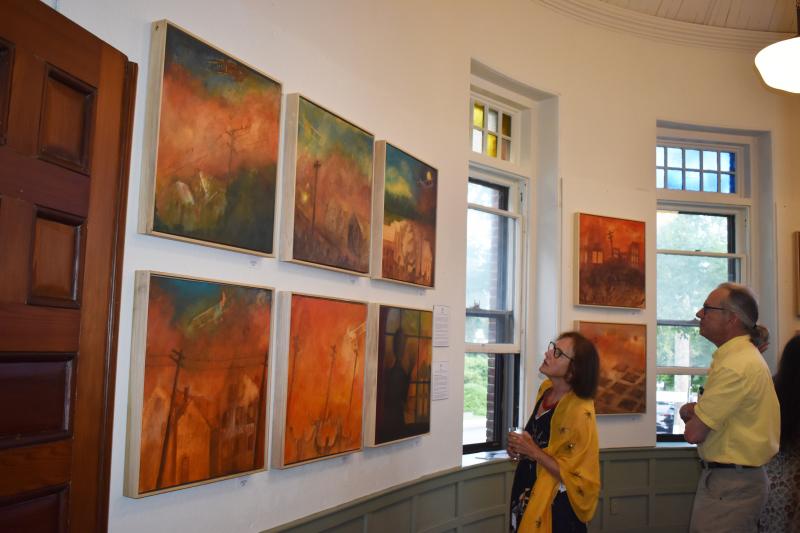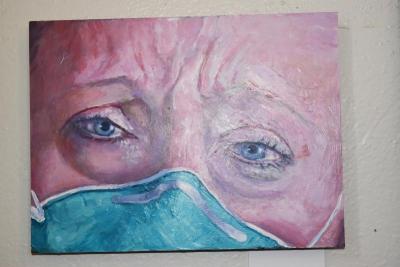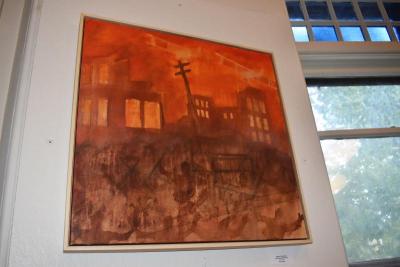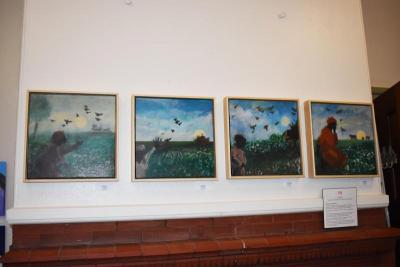Histories past and present on display at the Cultural Center
Exhibitions at the Dartmouth Cultural Center typically feature local landscapes .
This month, the center’s Reading Room Gallery will instead feature more works that will have patrons reflect more on the histories past and present this country has gone through as part of “Reckoning: Uncomfortable Realities from Our Collective Past and Recent Experiences.’’
The new exhibition features the recent works of Dartmouth painter Stephen Remick’s “Covid Healthcare workers” series and Fairhaven-based artist Ron Fortier’s “America’s Guernica” Greenwood.”
“It’s a very different type of exhibit,” Center co-Treasurer Kathy Del Sordo said. “It makes you think.”
Fortier’s latest works are a series of 10 paintings depicting what he calls “America’s Guernica:” the aerial bombing of the Greenwood district of Tulsa, Oklahoma 100 years ago.
In 1921, mobs of White residents attacked Black residents and destroyed homes and businesses in what was then known as “Black Wall Street” — which was at the time one of the wealthiest Black communities in the country — after a Black man was accused of assaulting a white woman.
“When I first heard about this, it started gnawing at me,” Fortier said. “There were marauding bands breaking down doors and using torches to light drapery on fire while people were still in their homes — it was absolutely pure hatred.”
To capture that history, Fortier said that he tries to “get in these people’s shoes” and harness the fear that happened during what he says is the “psychological reality” of that event.
“It was like having my guts pulled out,” the artist said.
Along with his “America’s Guernica” paintings, Fortier also displayed a more personal series, “Charity Ann: Gone.”
The four paintings showcase the Fortier’s wife’s third great grandmother — an enslaved woman in Virginia — crying at a wagon as her daughters were sold away. According to the artist, only one name survived the passage of time: Charity Ann, one of the two daughters.
“It’s a testimony to the reality of slavery and the audacity of the false construct of white supremacy,” he said of his sereis of paintings.
Meanwhile, Remick’s works focus on more recent history: profiles of healthcare workers who were on the front lines of the Covid-19 pandemic.
Remick said he typically works on landscapes, but the Dartmouth artist said that after he saw Instagram selfies of nurses who were working in ICUs at the height of the pandemic, he wanted to capture and showcase “the true essence of what hit them.”
“It stopped me in my tracks,” he said. “They were doing this to alert the world, so I thought I could further this cause by maybe hitting a different audience.”
The 15 faces on display come from all over the world — including Italy, Brazil, and Wisconsin — and feature some of the posts those workers shared about their realities such as being unable to return home after a shift to avoid contaminating their families.
Though they were from different parts of the globe, Remick said they all had the same commonality.
“They were all going through this — wrapping up four body bags a day,” he said.
While the artists focused on differing subjects, they both shared a common goal with the Cultural Center’s latest exhibition: to expose the unconscionable.
“They both mirror each other,” Fortier said. “One is the atrocities of the present, one is the atrocities of the past.”
The exhibition will run through Aug. 22. Hours are 11 a.m. through 3 p.m. Thursday through Saturday.



















